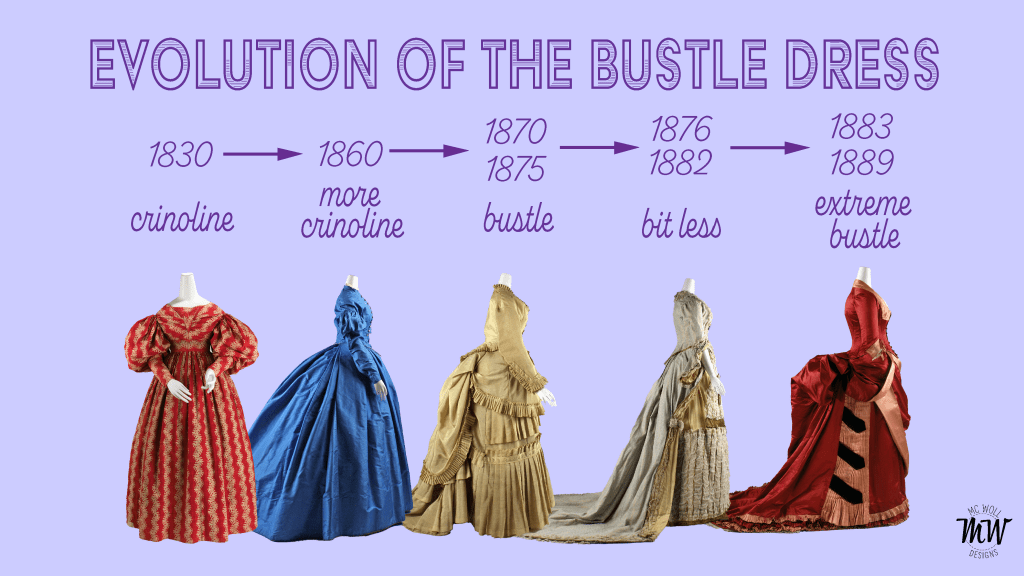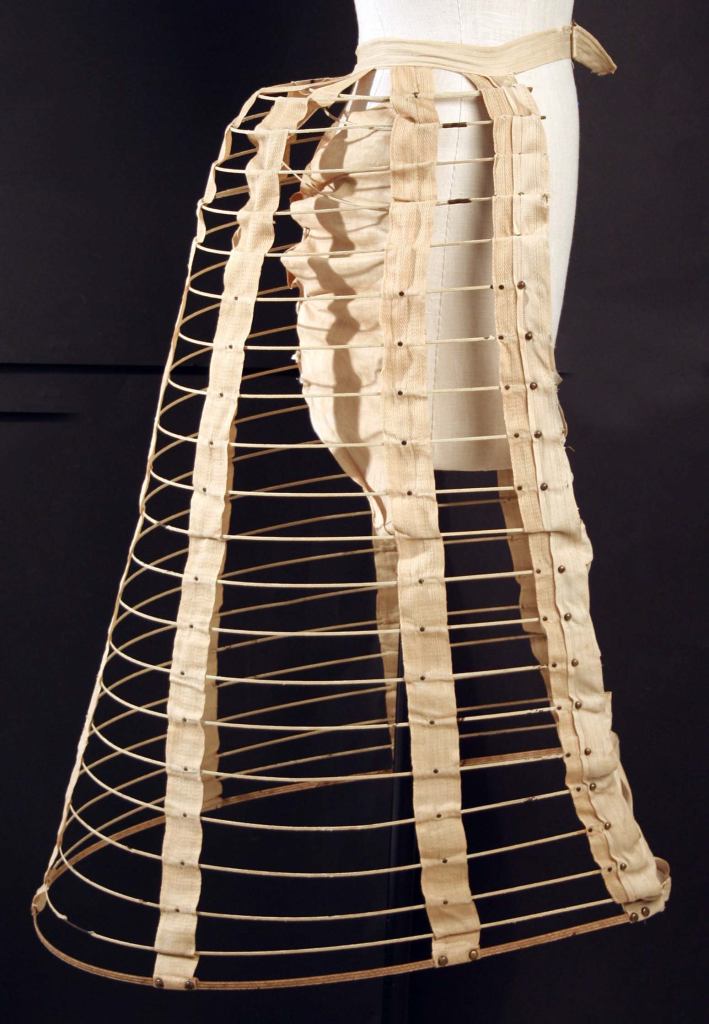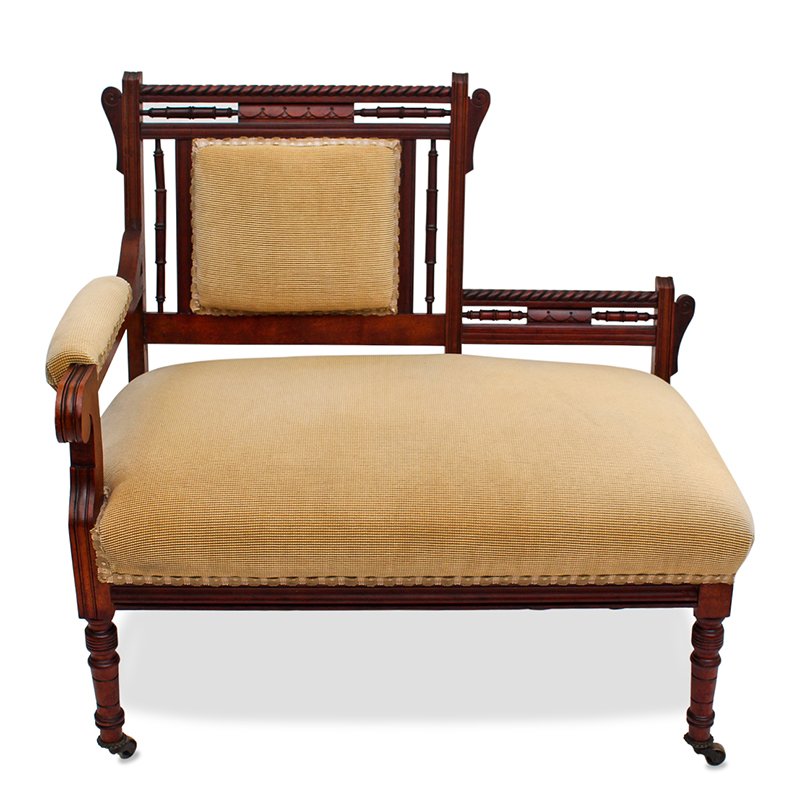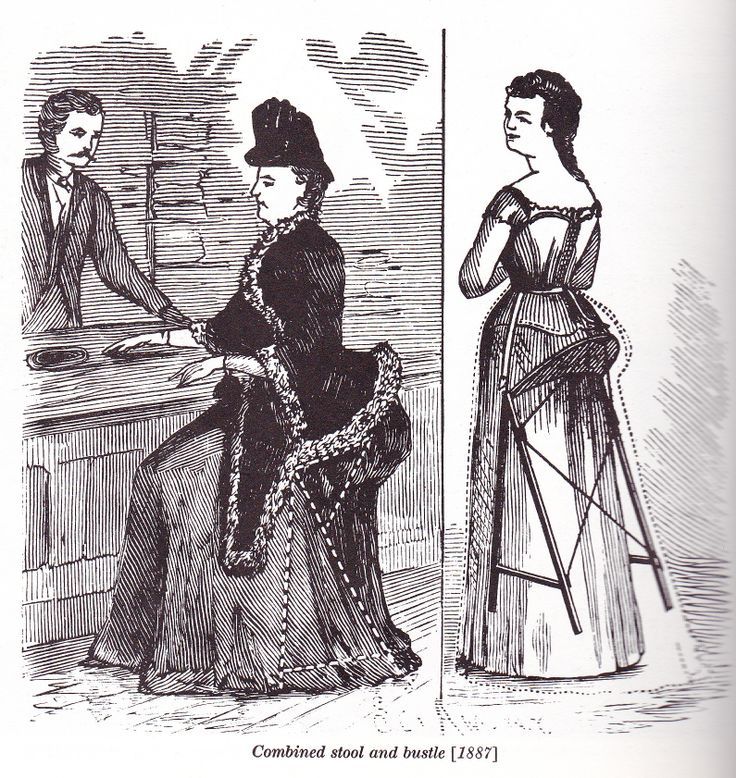Bustle (noun)
Marriam-Webster
Clothing: a pad or framework expanding and supporting the fullness and drapery of the back of a woman’s skirt or dress
Dress fashion took quite the roller-coaster ride throughout the 1800s. The first two decades (1800’s through the 1820s) saw the columnar Empire gown reign supreme—think Bridgerton. Beginning in the 1830s we began to see skirts widen again, this time with the assistance of cage crinolines, or hoop skirts. Walking around in your own personal bubble like Glinda the Good Witch grew tiresome (and dangerous—but that’s another post), and in the 1870s we see the next big shift.
Karen Bowman says it best in her book Corsets & Codpieces: “If Florence Nightengale called for moderation in a woman’s dress it was only to fall on deaf ears. Encased in their corsets and unwilling to forego the yards of beautiful fabrics that once covered their hoops and which they had fought so hard to retain, women, with stubborn gentility, simply flattened the front of their skirts, and gathered everything up at the back into one enormous lump resulting in the equally ridiculous fashion, namely the bustle”
Bustles themselves went through three distinct phases: the first bustle era only lasting about 5 years from c. 1870-1875; the “natural form era” from c. 1876-1882 where the bustle briefly disappears; and a revival period from c. 1883-1889 where the bustle comes back with a vengeance.

Lydia Edwards provides an excellent summary of the structural evolution of the bustle in her book How to Read a Dress: “In the very late 1860s, a smaller variety—usually featuring hoops only at the back and sides—were worn, with an extra arrangement of wires at the back to provide more support for gathering drapery. These were known as crinolettes or half hoops, and the flounced pads of horsehair tied around the waist, worn throughout both bustle eras, were referred to as dress improvers or tournures (the word bustle was thought indecent in polite society). Both devices helped produce first the softer, rounder, and higher bustle shape of the early 1870s, and then the sharper horizontal “shelf” that defined the final phase of the 1880s”



How did they sit?
With all the added fabric and hoop volume surrounding one’s derriere, one would imagine sitting to be rather problematic. Well, it was…and wasn’t. If metal hoops were used in the bustle’s understructure, they were most often made of watch spring steel which made them collapsible. Fabric of course is squishy. The trickiest part would be backing up to the chair, and then—just sit. Really the biggest obstacle was furniture itself. Chairs with arms were out of the question, as they did not allow enough room for all of the yards of fabric. Bustle benches became popular in sitting rooms. These wider seats had a back and one arm for the sitter, and more open space to one side to give all that skirt somewhere to go. To the contemporary eye, we may look at a bustle bench and call it a love seat, but there was only room for one.

Another alternative would be to carry around your own chair, and the inventors of the Victorian era did not disappoint. How about a combination stool and bustle? Yes, this was an actual patent that was filed in 1887. No bustle bench in the room? No problem! But is it something that would actually work? Morgan Donner built and took one for a spin in full Victorian dress, and it is well worth the watch (below). And further proving that fashion is cyclical (OK, calling this fashion is a stretch), there are tech and robotic companies right now working on wearable chairs. They’re more exoskeletons, but then again, we’re no longer wearing yards of fabric that double as concealment.

Not exactly legal uses

It may seem like bustles were more or less a fashionable inconvenience. But for some, they proved to be very convenient. “Fashionable smuggling” was on the rise with the popularity of cage crinolines and bustle cages. All that extra room under skirts and around hoops provided the perfect place for hiding goods (typically fashion-related) purchased overseas from customs officers. The vast majority of those participating in fashionable smuggling were dressmakers and milliners, bringing in materials and ready-made dresses for their clients. While most women of the era sewed, for dressmakers and milliners, sewing was their profession and their highly honed skills allowed them to creatively hide goods by sewing them into linings, or sewing pockets to petticoats and bustle cages. One account from the New York Times listed an inventory of what one milliner was able to hide in her skirts: 1,000 yds lace, 6 bottles of perfume, 6 lengths of silk, 3 dozen pairs of gloves, 12 bottles of brandy, and 10 ready-to-wear dresses.
A rather creative correlation between fashion trends and smuggling also began to develop. From Hind Abdul-Jabbar’s article Smuggled in the Bustle: “In a New York Times article titled ‘Smuggling Craft’ from 1879, the writer speaks of smuggling and its relation to current fashions, suggesting that the current trend of the fitted skirt is a direct result of the excessive smuggling occurring at this time.” However, considering that the bustle came back with a vengeance in the form of the shelf bustle, smuggling probably wasn’t the root cause of the brief shift in fashion trends. Correlation does not prove causation. But the bustle was truly badass. If you want to dive deeper down this rabbit-hole of international smuggling, I recommend listening to this episode of the Dressed podcast with Hind Abdul-Jabbar.
What other eras of fashion history would you like to explore? Let me know in the comments below!
Subscribe below to get posts right in your inbox! (post updates only–no spamming here!)
Want to use the above Evolution of the Bustle Dress graphic in a fashion/costume history lecture or for other classroom/presentation use? Download it below! If you’d like to support me in creating more fashion history posts & downloadable classroom content, you can buy me a virtual coffee. Thank you!


One thought on “Badass Bustles”